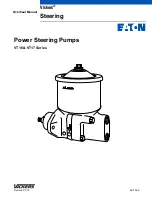
Page 76
PSI 9000 2U Series
EA Elektro-Automatik GmbH
Helmholtzstr. 31-33 • 41747 Viersen
Germany
Fon: +49 2162 / 3785-0
Fax: +49 2162 / 16230
3.9
Other applications
3.9.1 Parallel operation in master-slave mode (MS)
Multiple devices of same kind and model can be connected in parallel in order to create a system with higher total
current and hence higher power. For true master-slave operation, the units have to be connected with their DC
outputs, their master-slave bus and their Share bus. The master-slave bus is a digital bus which makes the system
work as one big unit regarding adjusted values, actual values and status. The Share bus will balance the units in
their internal current regulation, especially if the master unit runs a function like sine wave etc.
Compared to normal operation of a single device, master-slave operation has some limitations:
•
The function generator is not available on slave units as long as MS is activated
•
The MS system reacts differently to alarm situations (see below in
)
•
Resistance setting and control (CR) is not available
3.9.1.1 Wiring the DC outputs
The DC output of every unit in the parallel operation is simply connected to the next unit using cables with cross
section according to the maximum current and with short as possible length.
3.9.1.2 Wiring the Share bus
The Share bus is wired from unit to unit with an ideally twisted pair of cables with non-critical cross section. We
recommend to use 0.5 mm² to 1.0 mm².
The Share bus is poled. Take care for correct polarity of the wiring!
A max. of 10 units can be connected via Share bus.
3.9.1.3 Wiring and set-up of the master-slave bus
The master-slave connectors are built-in and must first be connected via network cables (≥CAT3, patch cable) and
then MS can be configured manually (recommended) or by remote control. The following applies:
•
Type of connection: RS485 with 115200 Bd
•
A maximum 10 units can be connected via the bus: 1 master and up to 9 slaves.
•
Only devices of same kind, i.e. power supply to power supply, and of the same model, such as PSI 9080-60 2U
to PSI 9080-60 2U.
•
Units at the end of the bus must be terminated (see below)
The master-slave bus (RS485) must not be wired using crossover cables!
Later operation of the MS system implies:
•
the master unit displays, or makes available to be read by the remote controller, the sum of the actual values
of all the units
•
the range for setting the values of the master is adapted to the total number of units, thus, if e.g. 5 units each
with a power of 1.5 kW are connected together to a 7.5 kW system, then the master can be set in the range
0...7.500 kW.
►
How to connect the master-slave bus:
1.
Switch off all units that are to be
connected and connect them
together with network cables
(CAT3 or better, not included). It
doesn’t matter which of the two
master-slave connection sockets
(RJ45, backside) is connected to
the next unit.
2.
Depending on the desired con-
figuration the units can then be
connected at the DC side. The
following configurations are pos
-
sible:
M
as
te
r-S
la
ve
PSU n
PSU n
PSU 1
PSU 2
DC
DC
M
as
te
r-S
la
ve
M
as
te
r-S
la
ve
PSU n
PSU 1
PSU 2
PSU 1
PSU 2
All units are connected
on the DC side
Only specific units are
connected on the DC
side
No units are con-
nected on the DC
side













































